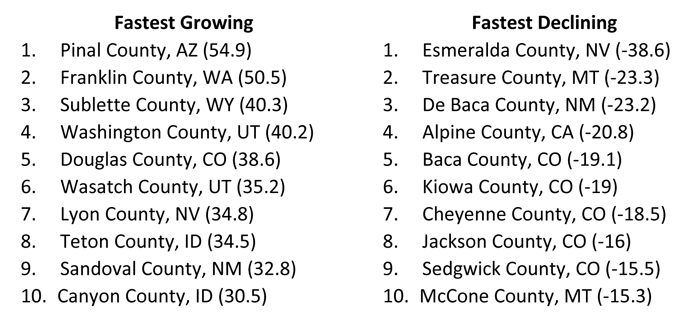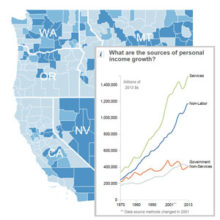- The fastest-growing places saw populations increase by more than 50% from 2003-2012, while the fastest-shrinking places saw declines of at least 15%.
- Counties specializing in high-wage services are among the fastest-growing, both from in-migration and natural change; while farm-dependent counties are among the fastest-shrinking, as younger residents move away and older residents age-in-place.
- While retirement destinations have relatively high death rates, these places often have vibrant economies attractive to younger movers, leading to overall population gain.

County populations in the West are constantly changing, shifting due to demographic and economic forces, as well as the draw of family and natural amenities. These trends depend on natural change; whether births exceed deaths—as well as net migration; whether more people are moving in or out.
One county’s population boom while and another county’s decline largely depends on the sectors driving the local economy and the type of workforce these sectors demand. We summarize the counties according to four typologies–high-wage services, farm-dependent, oil and natural gas boom, and retirement destinations – and assemble economic and demographic data that characterize these four county types. Although the categories are not exhaustive nor mutually exclusive, we find they explain much of the variation in population change across the West.
Trends in population change have long-term implications for the economic and demographic trajectories of counties. This post includes an interactive map showing individual counties’ population change and score for the four typologies, a sortable, county-level data table, and a review of popular and peer-reviewed literature focused on explanations for trends in migration.
Summary Findings
In most counties, the economy – and population change – is driven by several overlapping factors and they have characteristics of multiple typologies.
- In the fastest-growing places such as Pinal County, Arizona, Sublette County, Wyoming, and Franklin County, Washington, population increased by more than 50% from 2003-2012.
- In the fastest-shrinking places such as Huerfano County, Colorado, Golden Valley County, Montana, and Mineral County, Colorado, population has declined by at least 15% from 2003-2012.
- Counties specializing in high-wage services are among the fastest-growing in the West, both from in-migration and natural change.
- Counties with farm-dependent economies are among the fastest-shrinking, as their youngest residents move away and older residents age-in-place.
- The oil and natural gas boom in eastern Montana, Colorado, and New Mexico in the past five years has drawn new workers to places whose populations had been declining.
- While retirement destinations have relatively high death rates, these places often have vibrant economies attractive to younger movers, leading to overall population gain.
Ten fastest-growing and fastest-declining counties in the West, 2003-2012 (Change in number of people per year, per thousand residents)


Our interactive toolexplores data by county, and is available as a sortable data table.
County Typologies and Population Change
Below we briefly discuss the criteria included in the county typologies, how the top-scoring counties for each type are distributed across the West, and how the typologies relate to population change. For a detailed listing of the included occupations see the data methods paper.
High-Wage Services
The high-wage services typology measures the growth and size of employment in high-wage service sectors, and characteristics of the workforce employed in these sectors. Communities specializing in high-wage services are characterized by a highly educated, relatively young population, as many of the occupations, such as information services, data processing, and telecommunications, are new industries.
Although many of these places are metropolitan, including the Bay Area, Portland, Salt Lake City, and the Front Range, not all are. Rural and micropolitan counties, such as Gallatin County, Montana (Bozeman) can specialize in high-wage services if they are connected to larger markets via airports.
Of the 25 counties with the highest high-wage services score, all have experienced growth both from natural change and from in-migration.
Farm-Dependent
Farm-dependent communities are characterized by a large land base in farming, long-term relatively high earnings from farming, and a large share of local earnings and employment in farming.
Although these places, on the easternmost plains of Montana, Colorado, and New Mexico, are characterized by a history of successful farming operations, most have experienced a long-term population decline as land holdings consolidate and farm production becomes less labor-intensive. The exodus of the younger generation is compounded as fewer young families remain to replace an aging population. The population decline has been offset in some areas by an influx of new workers to support the oil and natural gas boom in eastern Montana and Colorado.
Energy Boom
We characterize oil and natural gas boom communities as having consistently high employment in the oil and gas sector relative to other communities in the West, and where production is actually occurring. This eliminates places like Denver and Billings, Montana which have businesses that serve the oil and gas sector. Finally, we account for the influx of the new employees needed to work in the oil sector by including places that have experienced a relatively large gain in working-age residents.
Oil and natural gas development has brought economic growth to some parts of the West, particularly to rural counties in the eastern edge of the region. This boom in demand for jobs has drawn workers to these counties, resulting in a wave of new residents. We also see a strong pattern of high birth rates in these oil boom counties.
Retirement Destination
Across the West, there are two types of aging communities: those that are aging because young people are moving away, and those that are aging because older people are moving there as a retirement destination. In our typology we characterize retirement destinations as places with a large older population that are also seeing growth across all age cohorts and have a rising housing market.
The places with the highest retirement destination scores are scattered across the West. In about half, deaths exceeded births, but in the other half births offset the high death rate. However, all of the top retirement destinations are experiencing high net in-migration.
Literature Review
Workers’ ability to move from places with high unemployment and low-paying jobs to places with low unemployment and high-paying jobs allows them to follow economic opportunity and is often cited as one of the American economy’s greatest strengths. However, Americans are moving less than they were 30 years ago and, when they do move, they are not necessarily seeking better economic opportunity. Additionally, those who do move now are more likely to move to places with fewer job opportunities and lower average pay, not more.
Researchers have found that rather than moving to follow jobs within the same industry, workers are more likely to use their skills in a different industry in the same place. For those who do move, it is more likely than ever before that it will be to a location with less expensive housing.
For further reading, see our detailed review of the popular and scholarly literature.
Conclusions
No single reason explains why counties are growing or shrinking in population. Instead, a combination of economic and demographic factors affects both migration and whether births exceed deaths.
We find that many growing counties can be characterized as one of three types – high-wage services, oil and gas booms, or retirement destinations. And counties growing the fastest are often have elements of more than one type.
Shrinking counties, by comparison, are often farm-dependent, as younger residents leave these counties. This is offset in some places where oil and gas development is occurring.
The reasons behind population change will determine the population and economic futures that counties can anticipate. Counties that understand who is moving to their area and what is attracting them can anticipate these new residents’ needs and continue to foster their community’s best assets.





